Tag Archive: intervention
September 16, 2012
by Carole Zangari -
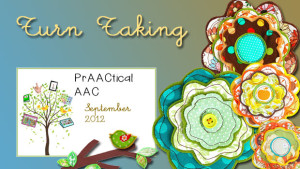
We’re always looking for new ways to represent things visually. Today, we’re sharing an idea from Amy Laurent on helping children take turns. You can view a video explaining the strategy she uses and download the visual support here.
Filed under: PrAACtical Thinking
Tagged With: ASD, intervention, pragmatics, social skills, turn taking, visual supports
September 2, 2012
by Carole Zangari -
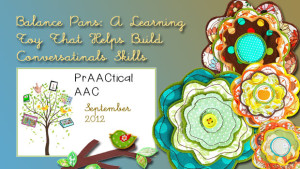
We’ve been thinking a lot lately about the social skills of some of our AAC friends who are not quite fitting in the way that they would like. SLPs frequently work on social interaction skills with learners on the ASD spectrum, but it’s not something that we always think about with learners who have cerebral palsy, apraxia, or other developmental disabilities. – The idea of using a balance scale as a metaphor for balance in conversational turns is intriguing and one we’ve explored a bit. In this video from Autism Teaching Strategies, Joel Shaul demonstrates the strategy and discusses it relative to turn-taking (Click here for Part 1 and click here for the second video). That makes sense for a lot of learners who don’t respond to non-obligatory situations as well as they could. – We’ve also used it for helping people with AAC see how their utterances compare to... [Read More...]
Filed under: Video of the Week
Tagged With: Conversation, intervention
August 26, 2012
by Carole Zangari -
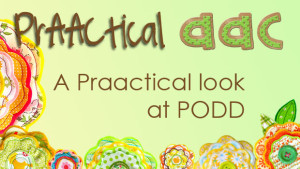
This week, we return to the team at the Autism and Tertiary Behavior Supports Project of the Kansas Technical Assistance Network. They have two wonderful videos by Jane Goetz and Lori Chambers on Pragmatically Organized Dynamic Displays. You can view ‘It’s All About the Interaction,” Part 1 and Part 2 . Also, look for the handout and tip sheet that accompanies these videos. –
Filed under: Video of the Week
Tagged With: ASD, cerebral palsy, communication, communication book, developmental disability, intervention, partner assisted scanning, PODD, resources
August 5, 2012
by Carole Zangari -
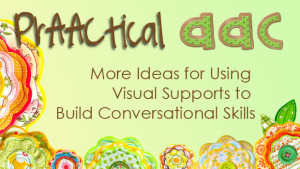
Cohesion is a tough concept for many of our learners who are developing their AAC skills and struggling to build relationships. In this week’s featured video, Joel Shaul, from Autism Teaching Strategies, discusses how to use two metaphors for building cohesive conversations. One is the idea of links in a chain and the other is the girders of a building. Of course, we are big fans of the use of visual supports whenever we talk and teach. — Although the focus here is learners with ASD, we’ve used this and similar strategies many kinds of learners. Hope you enjoy this informative video. – – – –
Filed under: Video of the Week
Tagged With: Conversation, intervention, resources, visual supports
July 29, 2012
by Carole Zangari -
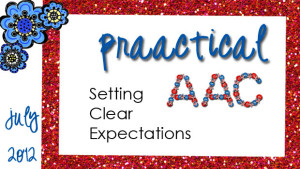
This week we return to the Geneva Centre for Autism for have two short videos from on strategies to support positive behavior. – Enjoy these explanatory videos on Clear Expectations With Visual Rules and Classroom Rules. –
Filed under: Video of the Week
Tagged With: ASD, implementation ideas, intervention, visual supports
July 25, 2012
by Carole Zangari -
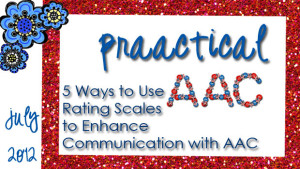
In an earlier post, we lamented the under-utilization of a quick and effective strategy: qualitative rating scales. You may not know them by that name, but we all know them. Also called Likert-type scales, we’ve seen these a multitude of times when we were asked to give an opinion. Strongly agree to Strongly Disagree. Excellent to Poor. Always to Never. – There are only a few guidelines to using these with AAC folks. One is to make sure to use appropriate visual supports. Literate AAC users may be very comfortable with text-only options, but for other learners, we need to add images so it makes sense to them. Another suggestion is to stick with an odd number of options: 5 seems to be the norm in clinical practice, but you can certainly adjust to fit the learner’s needs. For some, a 3-point scale would be best. Others may want more... [Read More...]
Filed under: PrAACtical Thinking
Tagged With: implementation ideas, intervention, rating scale, visual supports
July 22, 2012
by Carole Zangari -
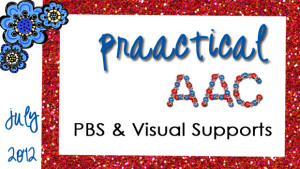
This week’s video comes from Katie Thomas of the Autism and Tertiary Behavior Supports Project of the Kansas Technical Assistance Network and deals with the who, what, when, where, and why of using visual supports to promote positive behavior. – There are several supporting documents including the PowerPoint handout, and some of the supports they review (e.g., calendar, first/then, wait card). We love the detailed description and the many examples they share. – Click here to view the video. –
Filed under: Video of the Week
Tagged With: ASD, behavior, implementation ideas, intervention, resources, visual supports
July 18, 2012
by Carole Zangari -
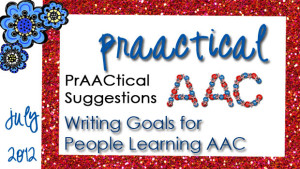
This post was inspired by a budding young professional who loves AAC and is DETERMINED to provide best practice services for the young students she serves. (See?? This is why we love being clinical educators!) We were chatting about a youngster on her caseload who uses an eyegaze SGD and is making some good progress with the technical aspects of it. Our conversation turned to goal setting. – First, a word about how to talk about AAC in the goals and objectives. For people who use SGDs, there are pros and cons to naming the actual device in the goal. Some SLPs favor that, while others prefer a more flexible approach and describe the device features. More about that another time. A more general concern about writing AAC goals is the tendency to focus more on operating equipment than on becoming an effective communicator. Clearly, we advocate the latter: AAC... [Read More...]
Filed under: PrAACtical Thinking
Tagged With: AAC system, communicative competence, goals, intervention, language, linguistic competence, objectives, operational competence, social skills, strategic competence
July 15, 2012
by Carole Zangari -
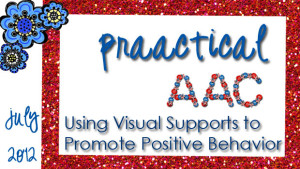
This week we have a series of short videos from the Geneva Centre for Autism on strategies to support positive behavior. Enjoy these explanatory videos on Supporting Positive Behaviors During Changes, Change in Routine, and Learning to Wait. –
Filed under: Video of the Week
Tagged With: ASD, behavior, implementation ideas, intervention, visual supports
July 14, 2012
by Carole Zangari -
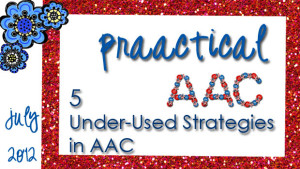
1. Partner-assisted scanning (PAS) offers great flexibility and spontaneity. Don’t want to take your SGD to the beach? A print-out of the screens and PAS is a great option. Missing key messages for the trip to the doctor’s office? A minute of brainstorming and the use of PAS may just save the day. No way for your client to access her device once she’s in bed? A communication board/book and PAS just might do the trick. – 2. Voice banking: For people are likely to lose their speech due to a degenerative disease, like ALS, the option of saving samples of their speech and having it digitized for future use seems to hold great appeal. We’d love to see more SLPs familiarize themselves with this strategy and the tools to implement it, so that this option is more widely used about individuals whose speech is deteriorating. – 3. Qualitative rating... [Read More...]
Filed under: PrAACtical Thinking
Tagged With: aided language input, ALS, ASD, intervention, partner assisted scanning, PAS, rating scales, resources, task analysis, teaching strategies, voice banking









